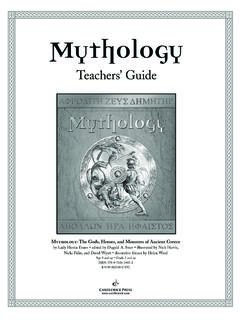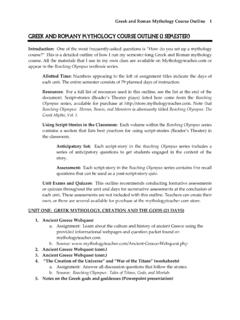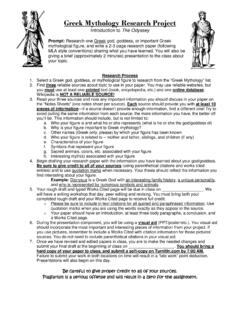Transcription of Dowden, Ken. The Uses of Greek Mythology. …
1 "'''''''''''''.. Dowden, Ken. The uses of Greek mythology . London and New York: Routledge, 1992. pp. x, 204. ISBN 0-415-06134-2 (cloth); 0-415-06135-0 (paper). Are the uses of Greek mythology our uses to know more about the Greeks or the Greeks' uses of mythology for their own purposes? It is the combination of both uses and their interrelation that makes this book different. Part I (Attitudes to Myth) sets Greek mythology in the context of mythology and popular lore in general and outlines the different kinds of sources we have for Greek myths. There is little or no discrimination among the range of sources from poetic exposition in epic, lyric and tragic form to prose collections like those of Apollodoros and Pausanias where the myths are presented in the form of local, familial and religious pre-history. A useful chapter then briefly de scribes and evaluates past and present theories about the origin, meaning, and impact of the myths.
2 D. makes clear the way in which, despite their diversity, these interpretations are not mutually exclusive and how most have a measure of validity. A survey of the Greeks' own aUitude toward myth takes note of both the scepticism of the pre-Socratics and eagerness with which early logographers both criticized and employed myths in their geographical and genealogical works. In presenting Herodotus' altitude toward myths D. fails to note the histo rian's very careful distinction between Minos' thalassocracy and that of the his torical Polycrates. And despite D., Thucydides' use of the Trojan War testifies less to his acceptance of it as historical than to his interest in magnifying the Pcloponnesian War. Plato's view of myth is briefly noted, and later historians' readiness to accept myth as history is clearly shown, but one would welcome speculation on the how and why of the change from simple belief to belief as history; the best parallel might be with lhe Lives of the Saints, so thal the role of religion in the changing view of myth should perhaps be explored.
3 90 Bryn Mawr Classical Review (1993) In Part II (Myth and the Past) I find puzzling D:s assertion: " Greek myth, like Greck religion, is very hard indeed to associate with other Indo-European cullures" (59). Rather he sees Greek myth as providing clues to Greek places and peoples important in the 'Mycenaean age and he finds lhe Aeolic element particularly strong in ilS easLward expansion, wilh the Trojan War as a reflection of prehistoric colonization. The Theban Wars are considered a doublet and as equally without historical value as the Trojan War, but the origin of the account is still presumed to be before 1300 Last in the section on Myth and Prehistory, the Return of the Heracleidae is viewed as an attempt to distance the Dorian Invasion from Heracles and the necessarily intervening mythical evenlS. But neglect of the Arcado-Cyprian dialect as evidence of Mycenaean withdrawal to Arcadia and Cyprusas well as too great a faith in a Mycenaean wall across the Isthmus tend to vitiate the argument.
4 Allhough properly sceptical about the amount of history that can be got from Greek myths, D. is apparently willing in the chapter on Myth and Identity to accept mythical eponyms as giving origins and interrelations among peoples and places. Left unclear is the extent to which the tribal groupings exemplified in lhe mythological stemmata belong to lhe myth-creating era and not to one or more of lhe later periods of myth-elaborating, myth-reconciling, and myth-cata loguing. And claims, whether to priority or land, operating as they do on a near national level, seem to belong more to a later deliberate manipulation of mythol ogy than to a time of its creation, which is admittedly more local in nature and purpose. Lumped together with such genuine "pre-peoples" as Leleges and Pelasgians are contemporary foreigners like Carians and Thracians who are seen to playa pre- Greek part in Greek mythology , perhaps to help define Greekness as over against primitives as well as in opposition to barbarians.
5 The mythologi cal origins of Athens, as one might expect from a highly self-conscious and comparative late-comer on lhe mylhological scene, are seen to be derivative, de tailed, and closely tied in willt the community's political development. Part III (Myth and Religion) is divided between two themes: myths of ar rivals or beginnings at the cult-site and myths of initiations. The hieroi logoi of Apollo at Delphi, Zeus at various birth-places, Apollo and Artemis at Sicyon, Demeter at Eleusis, and Dionysus in Greece are examined to show the way in which cult-foundation myths serve a purpose more explanatory and religious than historical. Still D. finds it possible to see in such myths various historical aUitudes toward lhe gods and their cullS. As for the myths associated with initia tions, again the search is for origins both of place and motive. The mythical connection of maidens wilh bears, deer and cows is seen to be functionally re lated to original rites of transition involving change of fonn and status.
6 Rather more fanciful is the effort to find in connection with Zeus LykaiGs and Lykourgos traces of a comparable wolf-pack transition for boys, especially when it is exemplified by the nine-year raid on Troy (by lite way, Diomedes is not an unmarried youth -in the Iliad). An account of a Cretan custom (not ritual?) of homosexual kidnapping initiating a "rite of passage" is combined with mythical instances of both homosexuality and Sacred Bands of Firly to show other aspeclS of boy-to-man transition. Still further to mark the "no-man's-land" of the transi Bryn Mawr Classical Review (1993) 91 tions themselves D. notes various mythical and ritual forms of transgression, transvestism and transexuality. In Part IV (The World of Myth) the attachment of myths to both places and social groups is explored. The whole world appears in myth: as actual context; by personification of its physical features or of earth's produce, both animal and vegetable; in the representation of wild places even to the ends of the earth; and in the portrayal of creatures beyond both good and evil, whether as gods, mon sters or such a heroic combination as Herakles in his double role of destroyer and civilizer.
7 In addition the life and works of three other specific heroes (Bellerophon, Perseus, Theseus) are outlined both to study varieties of initiatory testing and to test two theories of heroic plot-patterns. Mythic Society examines the locus and transfer of political power in the upper class world of myth, noting also its concern with conflict and the repression of various forms of barbarism. In that connection male domination in Greek myths is seen to result in both hos tile and circumscribed female roles. D.'s own conclusions as to the nature and importance of Greek myth may be briefly summed up: it is both a local and a national heritage; it tells of a past that created the present; it shows the mechanics of challenge and response or depar ture and return, whether in initiation or life; and is often chary of happy endings. This free-ranging and sometimes hit-or-miss classification and study of Greek myths and their uses is both entertaining and instructive largely because of its uncanonical approach and associations.
8 It is probably not for a beginner because it assumes some considerable acquaintance with names and plots. And it may annoy a student of Greek by its lack of chronological and source discrim ination among versions of particular myths. Because D. shows myths as per meating the whole fabric of Greek life and investing it if not with meaning at least with human interest, he does demonstrate that for the Greeks the uses of mythology were both multifarious and variable. But for our uses of that mythol ogy he is perhaps less helpful. His kaleidoscopic range from Homer to Heliodoros, from tragedy to travelogue, and from local to universal often dif fuses the picture and confuses the issue. The bibliographies (topical and general) are very useful in providing back ground and context for D.'s own presentation. Four different indexes make the book as easy to consult as it is to read. Mabel L. Lang Bryn Mawr College **









